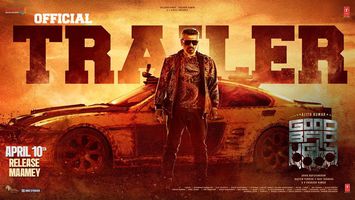There has been no dearth of legendary artists in the Hindi film industry, who, with their skills of engaging the audiences and involving them deeply in their artistic endeavours, have given a whole new level to the industry and created an epic period in Bollywood history, called as the 'Golden Era'. One such gem of the 'Golden Era' was Guru Dutt. He is one of the few Hindi film actors who have left their footprints on the sands of time in the history of Bollywood. Apart from being an actor, he was also a renowned director and film producer of the period.
Vasanth Kumar Shivshankar Padukone, famously known as Guru Dutt was born in Bangalore on July 9, 1925. His father Shivshankar Rao Padukone worked as a school headmaster and later as an employee in a bank. His mother was a private tutor and a school teacher and was also involved in translating Bengali novels in Kannada language. Guru Dutt was born to her when she was just 16 years old.
His childhood was no bliss as he had to suffer many unpleasant experiences. He had to witness the strain in the relations of his parents. His maternal uncle's family was hostile towards him, if that wasn't enough, he had a frightening experience from his maternal uncle. To add into this emotional turbulance, he had to go through the death of his seven month old brother, named Shashidhar.
Guru Dutt's early childhood was spent in Calcutta (Kolkata today). The Bengali culture was a significant influence for him in his formative years. His name Guru Dutt was actually a Bengali adopted name. His younger siblings, namely Atmaram, Vijay, Devidas and sister Lalitha were born in Calcutta.
He had a knack for making shadow plays on the walls against a candle light or light from an oil lamp. Though didn't receive any special training for this, he was excellent in doing this job. He once performed a shadow snake dance at a community event in Calcutta, for which he was awarded a five rupee cash prize. Despite of being a good student, financial issues kept him from going to college. Today's musical maestro, Ravi Shankar (as known those days), had an older brother Uday Shankar, having his own performing troupe. Guru Dutt joined the troupe and also the Almora based Uday Shankar India Culture Center at the age of 16 through a scholarship of seventy five rupees per year. However the Second World War led to the closing of the center.
Though initially, he worked as a telephone operator for a company at a factory of the Lever Brothers Company, in Kolkata, he soon left it and joined another one, which was found by his uncle, under a contract for three years, for the Prabhat Film Company, based in Pune. This was debut for Guru Dutt, where he played a small role of Lord Krishna in the film 'Chand'in the year 1944. He acted in the 1945 Vishram Bedekar film 'Lakharani' as well as assisted the director. In the following year, he did choreography and assisted director P. L. Santoshi for his film 'Hum Ek Hain'.
After the termination of the contract, he found a job for freelance assisting for Prabhat Film Company's CEO Baburao Pai, thanks to his mother. But unfortunately, he was unemployed after 10 months. In this period, he began English writing for 'The Illustrated Weekly of India', a local but popular English magazine. There he wrote the story of his film 'Pyaasa', which was almost an autobiography. Though it was originally named 'Kashmakash', it was changed into 'Pyaasa'. Though his marriage was initially with a girl from Pune, with whom he eloped, named Vijaya, but had to marry Suvarna, his niece from Hyderabad, under pressure from his parents.
Initially, though he was working for the Prabhat Film Company in the position of a choreographer, he was put into acting and also for assistant direction. Here he met Dev Anand as well as Rehman. After decline of the company, he shifted to Mumbai, where he worked along with Amiya Chakraborty in the film 'Girls School' and also with Gyan Mukerjee for 'Sangram'. Both were one of the top directors of that time. He also worked in the position of a director for Dev Anand's own company, Nav Ketan.
His first film with Nav Ketan was 'Baazi' in 1951.Soon, Dev Anand and Guru Dutt turned good friends. They made a mutual promise that if any one of them turned into a filmmaker, he would hire the other as the lead actor. Dev Anand fulfilled this promise through 'Baazi'and so did Guru Dutt through 'C.I.D.'.
Through his film 'Baazi', Guru Dutt made some technical contributions such as the 100 mm lens close shots, which is popularly known as the 'Guru Dutt shot'. During the making of the film, he also met 'Geeta Dutt' who was going to be his future wife. Though his 1951 film 'Baazi' was a great hit, his next ones 'Jaal' as well as 'Baaz' couldn't perform so well. However, they created a team, a talented one. He met as well as mentored V. K. Murthy in cinematography, Johnny Walker, a popular comedian and Abrar Alvi, popular writer and director.
His next film that achieved a great level of success was 'Aar Paar' in 1954, followed by other successes such as 'Mr. & Mrs. '55', 'C.I.D.' and 'Sailaab'. His 1957 film 'Pyaasa' which is about a depressed poet, who suffers tribulations and achieves success only after his death, is still considered as a classic. However, he had to taste extreme disappointment after the failure of his 1959 film 'Kagaz Ke Phool'. This actually devastated him. After this failure, he hired other directors to direct films from his studio. His yet another popular film 'Sahib Bibi Aur Gulam' was not only a great commercial success, but also a critical one and is also appreciated even today. The film was directed by Abrar Alvi, who was his protg, and he won the Filmfare Best Director's Award. There were rumors that Guru Dutt ghost directed the film, but were quashed by Waheeda Rehman.
His 1960 film 'Chaudhwin Ka Chand' was his last super hit film. His last film came in 1964, named 'Sanjh Aur Savera' by director Hrishikesh Mukherjee, where he acted as the male lead opposite to Meena Kumari. On the unfortunate day of 10th October 1964, he was found, lying dead in his rented Pedder Road apartment. It isn't known, if it was a suicide or death by accidental overdose. At that time, he was already into two projects namely 'Picnic' and 'Love and God' by K. Asif.
It is said that his personal problems with his wife Geeta Dutt, made him take this step. Asha Bhosle once revealed that Guru Dutt had called her in the mid-night, to ask if his wife was at her home, which she wasn't. Guru Dutt had three children from his wife, namely Tarun, Nina and Arun. It was primarily his unpleasant married life that led to his death. His heavy smoking and drinking along with his odd hour schedule created problems in his personal life. On that fateful night, the Hindi film industry lost one of its most precious gems. The reflection of his working style can still be seen in his proteges, such as Raj Khosla.

















